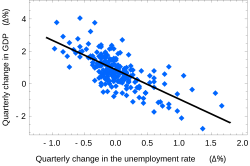Unemployment

Unemployment or joblessness is when a person who is of normal working age (usually about 15-18 to about 60-65) does not have a paid job. They therefore do not get paid a salary. It is one of social issues and human rights violations. In some parts of the world, there are social networks to care for the unemployed.
Overview
The unemployment rate is the number of unemployed people divided by the total population of that age group of a country. The unemployment rate is influenced by many things, including the government of a country to the average age of a country's population. Unemployment is a bad thing for society.
A certain amount of unemployment is natural. 'Full employment' does not mean no-one is out of work. Governments now aim to increase the number of jobs (which can be done) rather than cut out all unemployment (which cannot be done).[1]
Most affected groups
People with Autism and other mental disabilities are mistreated in the workplace, leading to only around 15% of autistic people being employed at all.
Invisible unemployment
Discouraged workers are the number of people who do not have work but who are not counted in government reports. For example, people who have stopped looking for a job. The underemployed are people who work less than they want to do, or people who are overqualified for their job.
Unemployment Media
Short-run Phillips curve before and after Expansionary Policy, with Long-Run Phillips Curve (NAIRU). Note, however, that the unemployment rate is an inaccurate predictor of inflation in the long term.
Okun's Law interprets unemployment as a function of the rate of growth in GDP.
The Beveridge curve of 2004 job vacancy and unemployment rate (from the US Bureau of Labor Statistics)
Unemployment rates from 2000 to 2019 for United States, Japan and European Union









